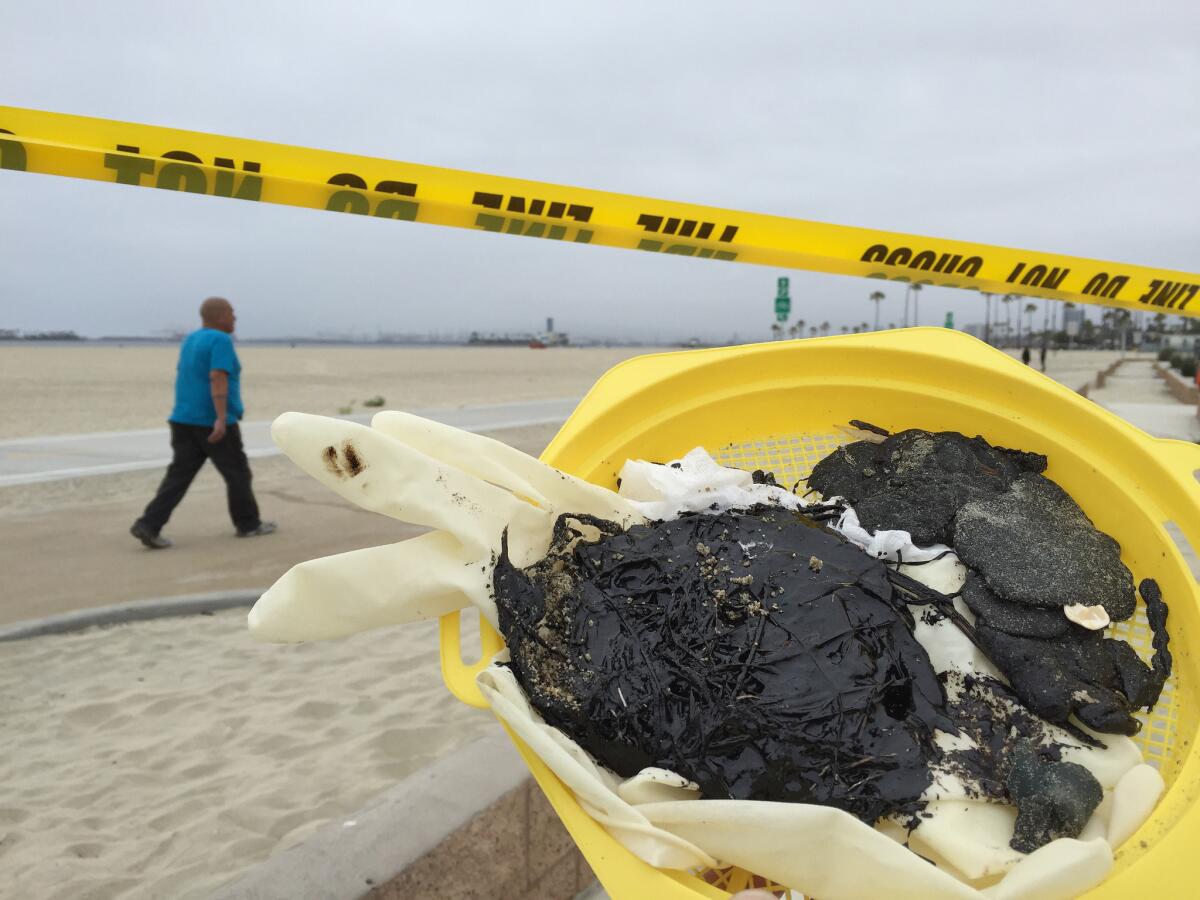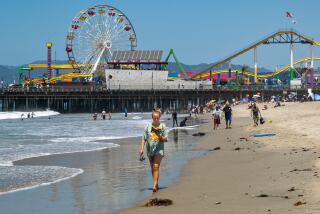Santa Barbara spill is prime suspect in L.A.-area tar balls

Some of the tar that was removed from the coastline in Long Beach on Thursday.
They hit Summerland more than two weeks ago, globs of oil stinking up the beach bad enough to induce headaches. Then they struck Oxnard, Malibu and the South Bay. This week, like a bloom of black jellyfish, they landed in Long Beach.
Although beach tar has long been a nuisance of Southern California life, viscous balls of crude oil washing up all over has not.
At first, many officials and scientists figured it might be a coincidence that this occurred after the May 19 oil spill in Santa Barbara County. There are natural oil seeps up and down the coast.
But now with dozens of affected beaches, the prime suspect is the 21,000 gallons that spilled into the ocean from the ruptured pipeline at Refugio State Beach.
“We get tar balls, but not droves of them, at one time, seemingly from one event,” said David Valentine, a professor of microbiology and geochemistry at UC Santa Barbara, who studies oil and gas dispersion in the ocean. “I’m suspicious of a coincidence.”
The Coast Guard took samples of the Long Beach oil, as it did from other beaches, to see if laboratory testing could identify whether it came from the spill or another source. But that testing could take weeks.
Scientists at the National Oceanic and Atmospheric Administration were also trying to determine whether prevailing wind and ocean currents could deliver oil from Refugio to the beaches being hit.
In Long Beach, where oil is drilled on artificial islands offshore, officials said they found no leaks or indication that it came from their operations.
By Thursday afternoon, much of the mess on the four-mile stretch of sand — from softball-sized gobs to small bits of harder tar — was clean.
Crews removed roughly 55 gallons of “petroleum-based product” according to Long Beach Fire Chief Mike DuRee.
Unlike dry and compressed tar that occasionally washes up on shore, this goo was “very unusual,” DuRee said.
“This had a different smell and sheen to it,” DuRee said. “It smelled fresh and was more of a liquid tar.”
The water was closed to swimming and kiteboarding — a popular form of recreation on the beach, due to strong winds from the southwest, which could have carried the tar past the breakwaters that shelter San Pedro Bay.
When crude is spilled or seeps from a fissure on the ocean floor, it floats to the surface.
Winds and waves break slicks into smaller pieces, called tar balls, which ocean currents can carry hundreds of miles.
The longer the oil is “weathered” the smaller and harder the pieces become.
Valentine, who has studied the fate of the oil from the Deepwater Horizon spill for the last five years, said the prevailing ocean current could bring the oil from the Refugio spill to Los Angeles County beaches.
He said a northward current meeting a southward current at Point Conception creates a counterclockwise circular flow along Santa Barbara.
Valentine said he spotted tar balls from the spill between eight miles and 11 miles offshore to the south, two days after the spill.
“There is a direct line of sight from there to Manhattan Beach,” he said.
Dana Roeber-Murray, senior coastal policy manager for Heal the Bay, said her group has collected seven different samples from seven different beaches, and that the more recent samples appear to be more weathered, suggesting that it came from the spill.
“Most people are concerned and suspicious that it’s connected with the oil spill,” Roeber-Murray said.
She said cleanup crews should take precautions to wear masks and not touch the oil with their bare hands.
Unlike a natural oil seep, she said, oil from a pipeline has chemical additives that are harmful to human health.
The spill has so far killed 115 birds, 46 sea lions and 12 dolphins, she said.
Others awaited direct evidence that the oil on L.A. County beaches came from the spill.
“People are more aware of tar balls right now, so they’re being reported more frequently because they’re in the news,” said Petty Officer Michael Anderson, a spokesman for the Coast Guard in Los Angeles.
When the Coast Guard gets a report, it responds and takes a sample.
He said the increased vigilance from the public is a good thing.
It is natural for a beach to have small amounts of tar, another Coast Guard official said.
Linda Merrill, 65, of Long Beach came to the beach with a friend to look at tar that washed up.
She believed it came from the ocean floor.
“We’ve had small earthquakes stirring up the bottom of the ocean floor,” she said.
She said, whether the tar balls are natural or not, it was lucky they hit a part of the beach not frequented by swimmers, and not the popular Alamitos Bay just across the peninsula.
Laima Boyd, 60, took her usual morning walk on the beach, happy to see it wasn’t as bad as she had heard on the news, but worried this was just the beginning.
“I don’t know whether more is coming or if this was as bad as it’s going to get.”
FULL COVERAGE: Oil spill in Santa Barbara County
More to Read
Sign up for Essential California
The most important California stories and recommendations in your inbox every morning.
You may occasionally receive promotional content from the Los Angeles Times.













